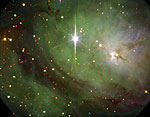|
|
||||||
|
|
Color Images from South African Large Telescope Mark 'First Light' for Africašs Giant Eye
"It's extremely gratifying to see the first images," said Richard Griffiths, professor of physics at Carnegie Mellon and one of the scientists instrumental in launching this project.
Located in the Karoo town of Sutherland, South Africa, SALT is the largest optical telescope in the southern hemisphere. Astronomers will now be able to study the southern skies and its objects that are critically important to modern astronomy but not discernable by telescopes in the northern hemisphere. Modelled on the Hobby-Eberly Telescope in Texas, the two telescopes will give nearly complete coverage of both hemispheres.
"The SALT project represents a leap forward in astronomical technology and has become an iconic symbol for what can be achieved in Science and Technology in the new South Africa," said project scientist David Buckley at the South African Astronomical Observatory.
Beginning in late 2005, Griffiths will begin collecting data to study very distant galaxies and quasars. He says this data should help clarify aspects of cosmic evolution.
The SALT project started about seven years ago as an initiative of South African astronomers with support of the South African government. It has grown into a global engineering project with partners from leading scientific institutions in six countries, on four continents, whose scientists have helped to finance, design and build SALT.
South African President Thabo Mkeki will formally open SALT on Nov. 10.
Lauren Ward |
||||
|
Carnegie Mellon Home |
||||||
